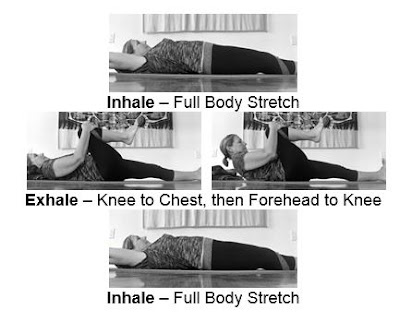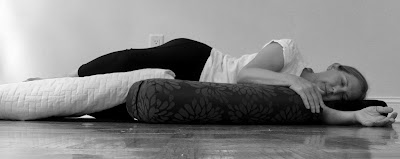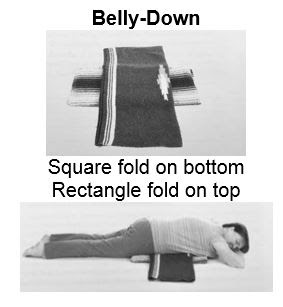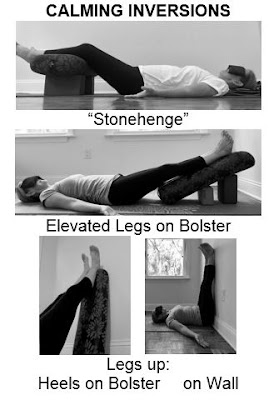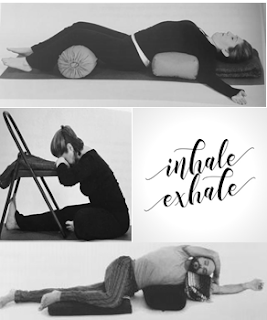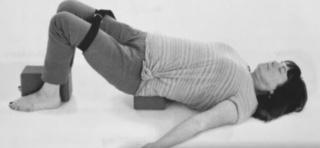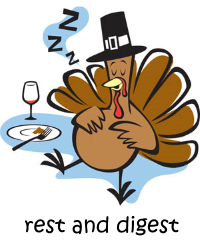
'Tis the season for eating more than you normally do! Overeating can make you feel sluggish and you may also experience digestive upset. This practice focuses on activating your Rest & Digest response, reversing the effects of stress, and supporting the muscles in your abdomen which promote healthy digestion.
NOTE: It is best to wait 2 (or more) hours after eating to practice yoga. Also, this and any other exercise program may cause injury. Consult your medical professional before beginning this or any other exercise program.
Props: Bolster, firm pillow or cushion; 2 blankets, 2 yoga blocks or thick books; optional = eye pillow or washcloth to cover eyes
Warm Ups:
1. WIND RELIEVING POSE - moves energy downward, opening up the digestive tract and relieves tension in the back.
(3 repetitions per side): Legs extended long down the mat or, if this is not comfortable, knees bent, feet flat on the mat. Move as indicated in photo above.
Move with your breath, calm, slow breaths.
2. SIMPLE SEATED TWIST - In addition to supporting a healthy spine, twists help to squeeze and tone the abdominal organs; stimulate the fresh flow of blood and lymph; and encourage the nervous system to refresh itself.
(3 repetitions per side): Inhale = center, exhale = twist to right, repeat to left. Breathe slowly in, extend the spine. Breathe slowly out, release into the twist.
Restorative Poses:
** Feel free to make any adjustments. Build/stack the props up to your body rather than straining to bring your body down to the props. Take a few moments to make adjustments as you come into each pose so that you are comfortable, able to release your weight down into the props, and relax. **
DIGESTIVE POSE - Resting on the LEFT side, especially after a large meal, can aid digestion and increase the flow of lymphatic fluid.
(5- 8 minutes): Lie down on your LEFT side. Place a folded blanket the long way between your legs, from knees to feet;
a folded blanket under your head;
and a bolster in front of your chest.
Rest your top arm over the bolster, extend and rest your bottom arm.
Slow, calm, and easy breaths ...
SUPPORTED CHILD'S POSE - May people find that this pose can relieve constipation, gas, and bloating.
(3 - 5 minutes): block(s) under bolster to create an incline; add blankets to bring bolster towards body, if needed; a rolled/folded blanket can also be placed under your hips. *Placing a folded blanket at your lower abdomen before lowering onto the bolster may help to stimulate your digestion system.*
Halfway through the pose, turn your head to the other side.
Allow your breath to simply rise and fall, flowing in and out, softening everything in its path.
STONEHENGE - If you have a history of Reflux Disease or chronic heartburn, take care with inversions (Legs Up the Wall, etc.) as it may increase the symptoms. If you suffer from nausea or diarrhea, you may find this pose helpful as it is a gentle inversion.
(7 - 10 minutes): Place two blocks 6 – 8 inches apart; place a bolster across the blocks; blankets under back and/or neck, as needed; rest your calves on top of the bolster. Optional= eye pillow/washcloth over eyes.Welcome your breath ... aware and at ease.
BELLY-DOWN POSE - This pose offers gentle pressure to the abdominal area, supporting digestion. It can also be emotionally soothing.
(3 – 6 minutes): Place a square folded blanket across the middle of your mat; then place a rectangle folded blanket on top of it; lie with belly down; position your pelvis on the center of the blanket stack; toes turn in; stack hands and rest forehead or cheek on them. Halfway through, turn your head to the other side.
Let your body soften into the blankets, release your weight down into the floor.
SUPPORTED BELLY-DOWN TWIST - Closed twists tend to provide a deeper pressure on the abdominal organs than open twists since they compress the spaces within the body.
(3 minutes per side): place block(s) under bolster to create an incline; bend and stack your legs, placing a blanket from knees to ankles for comfort; face the bolster, belly button aligned with the center, arms on either side; inhale and on the exhale release onto the bolster; face away from your bent knees or, if that is not comfortable, turn your head to face your bent knees; rest your arms on the floor or folded blankets.
With each exhale gently unravel any tension ...
SUPPORTED RECLINING BOUND ANGLE POSE - This pose creates a gradual slope from your head to your hips. Therefore, it's possible that this pose can help with problems such as constipation and sluggish elimination.
(7-10 minutes): place block(s) under bolster to create an incline; release your back down onto the bolster; soles of the your feet come together; Optional = folded blankets under your knees and arms for comfort.
Pranayama/Breathing: Rest & Digest
Take several slow, calm, and easy breaths. Swallow to release your jaw, cheeks, and tongue. Let yourself rest completely on the props, on the earth. With each breath know that you are safe and supported.
Welcome your breath with a receptive belly, gently releasing tension ... while you simply rest ... and digest.

